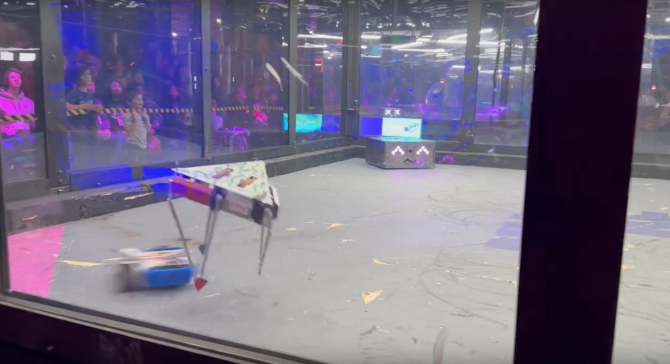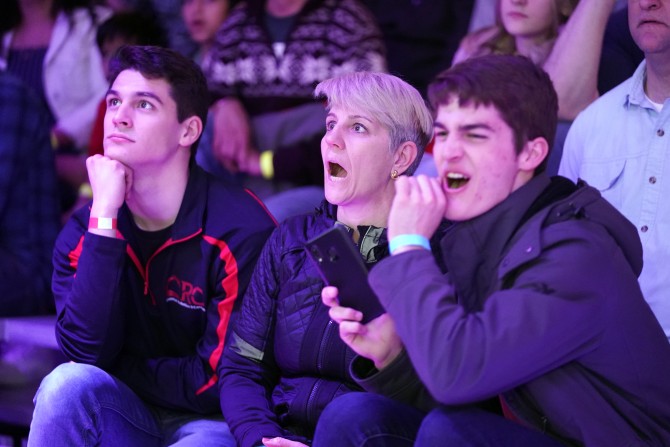
Members of Cornell Combat Robotics (from left) Molly Drumm, Sardor Rahmatulloev, Marcus Esposito and Alex Jenkins.
News directly from Cornell's colleges and centers
Combat Robotics flips competition, eyes upgrade with grant
By Syl Kacapyr
A boisterous applause came from the crowd as Florence the robot used three of its triangle flippers to elevate itself off the battle arena floor at the National Havoc Robot League’s March of the Bots competition, March 18, in Norwalk, Connecticut.
“I don’t know what the weapon is on Florence,” declared an announcer during a livestream of the event, which pitted robots in different weight classes against each other head-to-head in an enclosed cage using weapons such as spinning blades, battering rams and flame throwers.
“Its arms are acting as flails!” exclaimed the announcer as Florence began to spin rapidly and strike another robot with its flippers, much to the pleasure of the roaring crowd.
Florence was one of three robots entered into the competition by Combat Robotics at Cornell, a team of 36 students consisting mostly of engineering and computer science majors, split between four subteams. The team was founded in 2019 with the goal of creating a fun and inclusive environment where members can apply their education and enhance their skills. The team became an official Cornell Engineering Student Project Team in 2022.
“We may have lost the competition in the end but we definitely won the hearts of the crowd with Florence’s creative design,” said team member Sardor Rahmatulloev ’25, adding that a highlight of the tournament came when Florence used it’s flippers to jump over another robot that was quickly approaching to strike it.
Another robot, Rosie, scored a one-hit knockout in its first battle, but ultimately lost to the team’s third robot, Richard, which reached the quarterfinals of the competition.
“It was a great battle for our team,” said Luke Murphy ’23, vice team lead. “We were cheering for both sides and ultimately Richard’s vertical spinner bested Rosie’s horizontal spinner.”
Most importantly, said team lead Bruno Tassari ’23, the team learned from the experience and was able to discern improvements that can be made to each robot.
“Some of those revelations include how to better prepare the pit crew for spare assembly between rounds, how to more effectively use our flippers, how to avoid getting high-centered, how to better protect our motors from the dust and debris in the environment, and so much more,” said Tassari. “All in all, this was one of our best competitions yet, and we can’t wait for the next one.”
The team will be making those upgrades thanks to a $10,000 grant announced by the National Havoc Robot League as part of a recent round of Collegiate Robotics Grants. The grant will also help the Cornell team with travel expenses and fund key events, such as their annual showcase to be held in the Duffield Hall atrium on May 3.
“We plan to use the money to repair our damaged bots after the competition, and for the design and assembly of our two new 2023-24 robots, since we develop two new ones every year,” Rahmatulloev said. “Most importantly, the grant will allow us to develop a safer test box so that our robots can be used on campus for practice without us worrying about anyone getting hurt.”
Robot combat sports have been popularized by television shows such as Battlebots and Robot Wars, with teams like Cornell’s hoping to compete in the National Havoc Robot League World Championships this November.
Tassari said, for now, the team is focused on improving upon its strong showing at the March of the Bots competition.
“Our team was hyped leading up to the competition and we are happy we got to showcase our tenacity, creativity and strong team spirit.”
Media Contact
Get Cornell news delivered right to your inbox.
Subscribe



